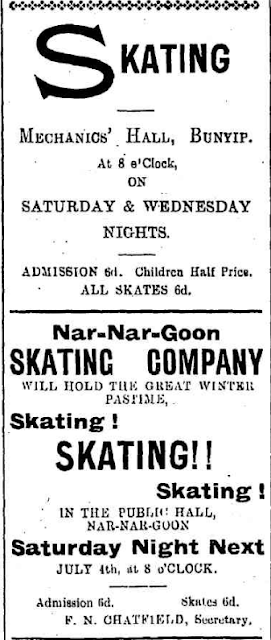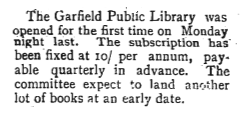The Bush Nursing Centre
The Bush Nursing Centre at Koo Wee Rup was established in July 1918. The Bush Nursing Hospital Movement began in 1910 with the establishment of the Victorian Bush Nursing Association (V.B.N.A.). At the time the current medical system consisted of big hospitals such as the Royal Melbourne which were run along charitable lines and whose role was to treat poor people, who could not afford to pay a Doctors fee. There were also private hospitals which only the wealthy could afford. To help offset medical costs Friendly Societies or Lodges were established which people could join for a yearly fee. This gave them access to the Friendly Society doctor and access to medicine dispensed from the Friendly Society Dispensary. There was also a growing move to nurse people in their own homes through what is now the Royal District Nursing Service. People in the city and the suburbs could have a nurse visit them to help recover from confinements and general illness. This type of service took pressure off the public Hospitals. Lady Dudley, the wife of the Governor General, was aware of these visiting nurses and had also seen firsthand the need for skilled nurses in the bush, so from these experiences came the idea of Bush Nursing Hospitals. Lady Dudley (1867-1920) promoted and raised money for the idea and thus the Victorian Bush Nursing Association began in 1910. (1)
To obtain a Bush Nursing Centre, the local community had to raise the money to fund the cost of the nurse’s salary, board, uniform and a ‘means of locomotion’. The salary was set by the Bush Nursing Association at the rate of around £80.00 per annum, the rate of pay for a hospital nurse with five or six years experience. The first Victorian nurse was appointed to Beech Forest in March 1911 (2). The first Bush Nurse at Koo Wee Rup was Nurse Homewood, who commenced work on July 1, 1918.
Ellen Amelia ‘Nell’ Homewood was born October 2, 1891 in Rockhampton, in Queensland, to Alfred and Margaret (nee Burns) Homewood, of Lavendale, Kunwarara. She was the seventh of their thirteen children. Ellen undertook midwifery training at the Rockhampton Women’s Hospital; four of Ellen’s sisters were also nurses, and two of them, Martha and Grace, served in the Australian Army Nursing Service in World War One. In 1917, Ellen was the Bush Nurse at Cowangie Hospital and from there she came to Koo Wee Rup.(3).
The Lang Lang Guardian
reported on her arrival in the town - Almost
as soon as she arrived Nurse Homewood's services were called into action at
Kooweerup. Little Jim Ellis had the distinction of being the first patient. On
Tuesday night the nurse was called to Dalmore, but got back in time for the
welcome. (4).
Bush nurses filled a great want in districts where the services of a medical man were unobtainable. They had a great many trials and difficulties to contend with, and it was their duty to alleviate suffering and save life. It was to their interest to join heartily in the movement and make it a great success. He welcomed Nurse Homewood to Kooweerup. The Lang Lang Guardian report continued Nurse Homewood, who is quite a young-looking girl, made an appropriate response, and hoped they would all work well together (5).
The next Bush Nurse was Nurse McKay, and I have no other information about her. Nurse McKay was followed by Mary Ellen Walsh, who took up the role April 21, 1920 (10). In February 1920, the Koo Wee Rup Sun reported that the Bush Nurse was forced to live three miles out of the town because while residents are desirous of having the services of a nurse in connection with the Bush Nursing Centre, yet there are no homes willing to take one in. This enforces her to stay at a residence three miles out, but she drives in very day to attend her duties. The position is very unsatisfactory. (11).
Since I wrote this, Barry Hester contacted me and told me that Mary Walsh was a very good friend of his grandmother, Margaret Hester (nee Knopp). When they were both living in Gisborne she delivered four of Margaret's children. Mary then moved to Koo Wee Rup to take up the position of Bush Nurse and convinced Margaret to also move to the area, which she did, buying a farm on McDonalds Drain Road. One of the incentives for the move was that Nurse Walsh said there would be work for the five Hester sons. Margaret's husband was a miner and so was frequently away. It is more than likely, as Barry said, that Nurse Walsh, after she arrived, that she lived out on McDonald's Drain with the Hesters. (12)
In 1920 it was decided to erect a hospital in Koo Wee Rup and in May of that year the following advertisement appeared in the Koo Wee Rup Sun. In the July it was announced that plans would be drawn up for a Fallen Soldiers' Memorial Hospital. (17).
Koo Wee Rup Bush Nursing Centre, Fallen Soldiers' Memorial Hospital opened in 1923
In May 23, 1923 the Bush Nursing Centre, Fallen Soldiers' Memorial Hospital was opened in Station Street. It was opened by the Shire President, Cr E.Simpson Hill. During the ceremony, Mrs Margaret Hamilton officially opened a ward in honor of the late Kitty Townson. I have written about these two women, here. The Hospital could accommodate medical, surgical and midwifery patients. There is a full report of the opening, here.At the ceremony a plaque was unveiled to honor the local soldiers who had not returned from the War. The names engraved on the memorial tablet are: - J. Banbury, D.G. Bethune, S. Blake, J. Bryant, T. Bryant, M. Callanan, L. Coates, P. Davis, J. Davy, C. Garbellini, H. Hamilton, J. Hannaker, R. Martin, C. Osborne, J. O’Shea, J. Randle, J. Slocombe, A. Williams, C. Woods. I have written about these men, here.
Koo Wee Rup Sun, May 3, 1923, p.1
galvanised iron and pulled his boy to safety up through the hole. Aided by others who came to the rescue, the 10 remaining patients in the wards were taken out in the same manner.
Mrs Mary Ann Bolleman, aged 59 years, another patient, held a baby in her arms above the water for 15 hours with the water surging above her neck before they were rescued. Mrs A. Adams and her baby which was born only the night before were being pulled out when the child was dropped into the water. She grasped the child's clothing frantically and saved it from drifting away. Both were raised through the opening to safety. (29).
.jpg)


























crop.jpg)




